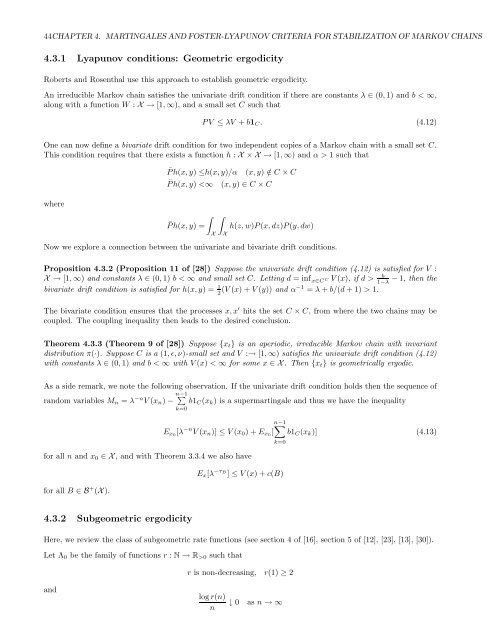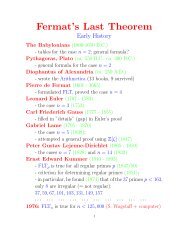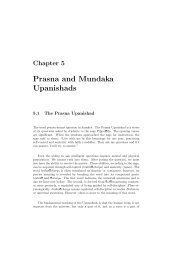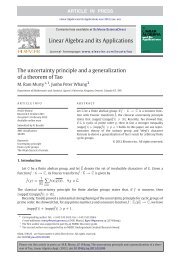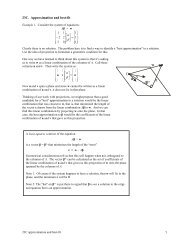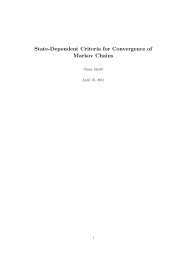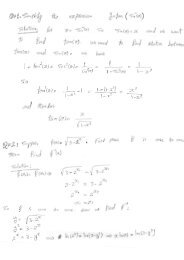Lecture Notes - Department of Mathematics and Statistics - Queen's ...
Lecture Notes - Department of Mathematics and Statistics - Queen's ...
Lecture Notes - Department of Mathematics and Statistics - Queen's ...
You also want an ePaper? Increase the reach of your titles
YUMPU automatically turns print PDFs into web optimized ePapers that Google loves.
44CHAPTER 4. MARTINGALES AND FOSTER-LYAPUNOV CRITERIA FOR STABILIZATION OF MARKOV CHAINS<br />
4.3.1 Lyapunov conditions: Geometric ergodicity<br />
Roberts <strong>and</strong> Rosenthal use this approach to establish geometric ergodicity.<br />
An irreducible Markov chain satisfies the univariate drift condition if there are constants λ ∈ (0, 1) <strong>and</strong> b < ∞,<br />
along with a function W : X → [1, ∞), <strong>and</strong> a small set C such that<br />
PV ≤ λV + b1 C . (4.12)<br />
One can now define a bivariate drift condition for two independent copies <strong>of</strong> a Markov chain with a small set C.<br />
This condition requires that there exists a function h : X × X → [1, ∞) <strong>and</strong> α > 1 such that<br />
where<br />
¯Ph(x, y) ≤h(x, y)/α (x, y) /∈ C × C<br />
¯Ph(x, y) b<br />
1−λ<br />
− 1, then the<br />
bivariate drift condition is satisfied for h(x, y) = 1 2 (V (x) + V (y)) <strong>and</strong> α−1 = λ + b/(d + 1) > 1.<br />
The bivariate condition ensures that the processes x, x ′ hits the set C × C, from where the two chains may be<br />
coupled. The coupling inequality then leads to the desired conclusion.<br />
Theorem 4.3.3 (Theorem 9 <strong>of</strong> [28]) Suppose {x t } is an aperiodic, irreducible Markov chain with invariant<br />
distribution π(·). Suppose C is a (1, ǫ, ν)-small set <strong>and</strong> V :→ [1, ∞) satisfies the univariate drift condition (4.12)<br />
with constants λ ∈ (0, 1) <strong>and</strong> b < ∞ with V (x) < ∞ for some x ∈ X. Then {x t } is geometrically ergodic.<br />
As a side remark, we note the following observation. If the univariate drift condition holds then the sequence <strong>of</strong><br />
r<strong>and</strong>om variables M n = λ −n V (x n ) − n−1 ∑<br />
b1 C (x k ) is a supermartingale <strong>and</strong> thus we have the inequality<br />
k=0<br />
for all n <strong>and</strong> x 0 ∈ X, <strong>and</strong> with Theorem 3.3.4 we also have<br />
for all B ∈ B + (X).<br />
n−1<br />
∑<br />
E x0 [λ −n V (x n )] ≤ V (x 0 ) + E x0 [ b1 C (x k )] (4.13)<br />
k=0<br />
E x [λ −τB ] ≤ V (x) + c(B)<br />
4.3.2 Subgeometric ergodicity<br />
Here, we review the class <strong>of</strong> subgeometric rate functions (see section 4 <strong>of</strong> [16], section 5 <strong>of</strong> [12], [23], [13], [30]).<br />
Let Λ 0 be the family <strong>of</strong> functions r : N → R >0 such that<br />
r is non-decreasing, r(1) ≥ 2<br />
<strong>and</strong><br />
log r(n)<br />
n<br />
↓ 0<br />
as n → ∞


